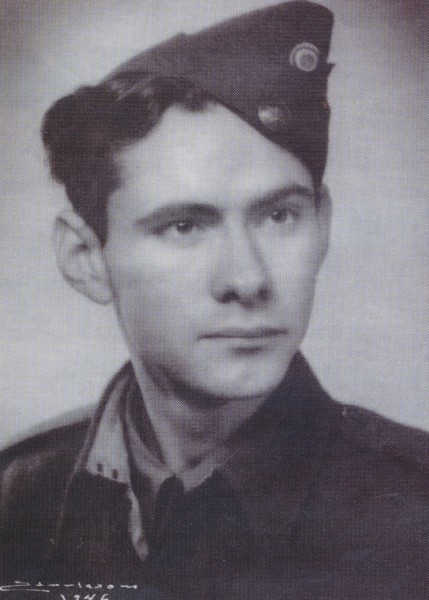Rolf Løvaas
Rolf Løvaas (16.02.1923–20.4.1996) was one of the early pioneers of the Norwegian gay movement, and was particularly active in the 1950s. In the spring of 1950 he was one of the founders and the first chairman of what started out as a Norwegian subsection of the Danish homophile organisation Forbundet af 1948, later to become an independent organisation with the name Det Norske Forbundet av 1948, or Forbundet for short. Løvaas was born and raised in Trondheim, but moved to Oslo in the autumn of 1945. He worked in advertising until 1965, when he started working as a journalist in NRK, the Norwegian public service broadcaster. Alongside writing articles he also created multiple radio programs.
‘We had to keep a low profile back then. Being gay had to be strictly hidden from friends and family’, Løvaas asserted in an interview with LGBT magazine Løvetann just before his death. In December 1950, Løvaas published an article where he strongly criticised paragraph 213 of the Norwegian Penal Code, which prohibited sex between men, and called the paraph ‘an inhumane relic’. He wrote the article under his own name, and was chastised by a superior at work following the publication, and told that ‘one does not write about such things’. This incident taught Løvaas that a pseudonym could be a necessary precaution. In the years following his first article on LGBT-issues, he wrote a series of articles and reader’s letters, most of which under the name Roald Lønne.
Autumn 1951 saw the publication of the Norwegian section of Forbundet af 1948s first pamphlet, Hva vi vil (‘What we want’), which Løvaas had written together with Øivind Eckhoff. After 2 1/2 years he resigned as chairman of the organisation, but remained on as a board member.
Letter to authors
Løvaas also wrote letters and included information about Forbundet to writers who had mentioned homosexuality, amongst them Alf Martin Jæger and John Hjertås. Løvaas had read Jæger’s book for young adults Ser du en stjerne (‘Do you see a star’), and congratulated the writer with having written a daring book. Jæger himself did not consider his book particularly daring, and mentioned Borghild Krane’s book Følelsers forvirring (‘The confusion of emotions’) , from 1937. It is strange that Jæger does not mention his own novel from 1924, Odd Lyng, which has a homosexual protagonist. Jæger also asked if Forbundet was not rather isolating: ‘Would it not be better if one openly agitated to remove this paragraph [213] which is an embarrassment for a cultured state.’ (RA, PA–1328: letters to Løvaas, 7.3.1952.)
John Hjertås received a lot of public attention following the publication of his 1936 novel Under brottskavlen, about boys at a boarding school in Nordland. He wanted to meet Løvaas for a conversation about Forbundet, but was ‘unsure if this was the correct way to solve the issue for those really in trouble’. (RA, PA-1328: letter to Løvaas, undated, ca 1951.) Towards the end of his life Løvaas again came to fight actively for the gay cause, and wrote several articles in LGBT magazines Løvetann and Fritt Fram. He was particularly interested in highlighting the important work done by the pioneers of the Norwegian gay movement. His reason for this was that it was frequently assumed that the work of the Norwegian gay movement only began with Kim Friele, an assumption Løvaas wished to dispel.
Dedication to LGBT history
Løvaas’ longstanding dream was to one day establish a center for documentation of the gay rights movement in Norway. He had collected a large archive of press clippings. In 1995 he unsuccessfully tried to interest a publishing house in publishing a book project titled Vi løsnet et skred. Glimt fra homobevegelsens pionertid 1950-1965 (‘We started an avalanche. Glimpses of the pioneering age of the gay movement 1950-1965’). This turned out to be a manuscript in need of significant editing and reworking. It consisted of 74 articles from newspapers and journals. The introduction was written as an interview Løvaas conducted with himself, reproduced in Løvetann nr 1/2000.
In an interview he claimed to be strongly against ‘outing’, but Løvaas also wrote a series of articles titled Navn fra fortiden ('names from the past') where he discusses in total about 40 norwegian men he claimed could be linked to homosexuailty. The articles contain a string of more or less famous names, amongst others several authors and artists.
Forbundet was not the only organisation in which Løvaas was active right from the start - he was also a part of the Norwegian Humanist Association, a secular humanist organisation, right from it started in 1956. When Rolf Løvaas died in april 1996, the Norwegian open church group (Åpen Kirkegruppe) were in charge of his funeral. Two members of this group stood guard with each their rainbow flag by his coffin as the attendees said farewell to the first chairman of Det Norske Forbundet av 1948.
Bibliography
Didriksen, Nina. 1996. 'At vi torde'. Interview in Løvetann no. 3, p. 27-30.
Heli, Arne. 1996. 'Rolf - din innsats må aldri bli glemt!' Løvetann no. 3, p. 6
Løvaas, Rolf. 1993. 'Strid uten våpengry. Homobevegelsens første år – 1950-1955' in Løvetann no. 6, p. 18-27.
Løvaas, Rolf. 1994. 'Hvem ville bli med?' Løvetann no. 1, p. 21.
Løvaas, Rolf. 1994. 'Navn fra fortiden'. Del I-III. Løvetann no. 2, p. 8-11, no. 3, p. 18-21, no. 4, p. 18-21.
Løvaas, Rolf. 1995. 'Pionertiden - bare kaffekos?' Løvetann no. 4, p. 11-13.
Løvaas, Rolf. 2000. 'En nølende formann'. Rolf Løvaas intervews himself. Løvetann no. 1, p. 12- 13.
Riksarkivet (RA): PA–1328, Rolf Løvaas.

